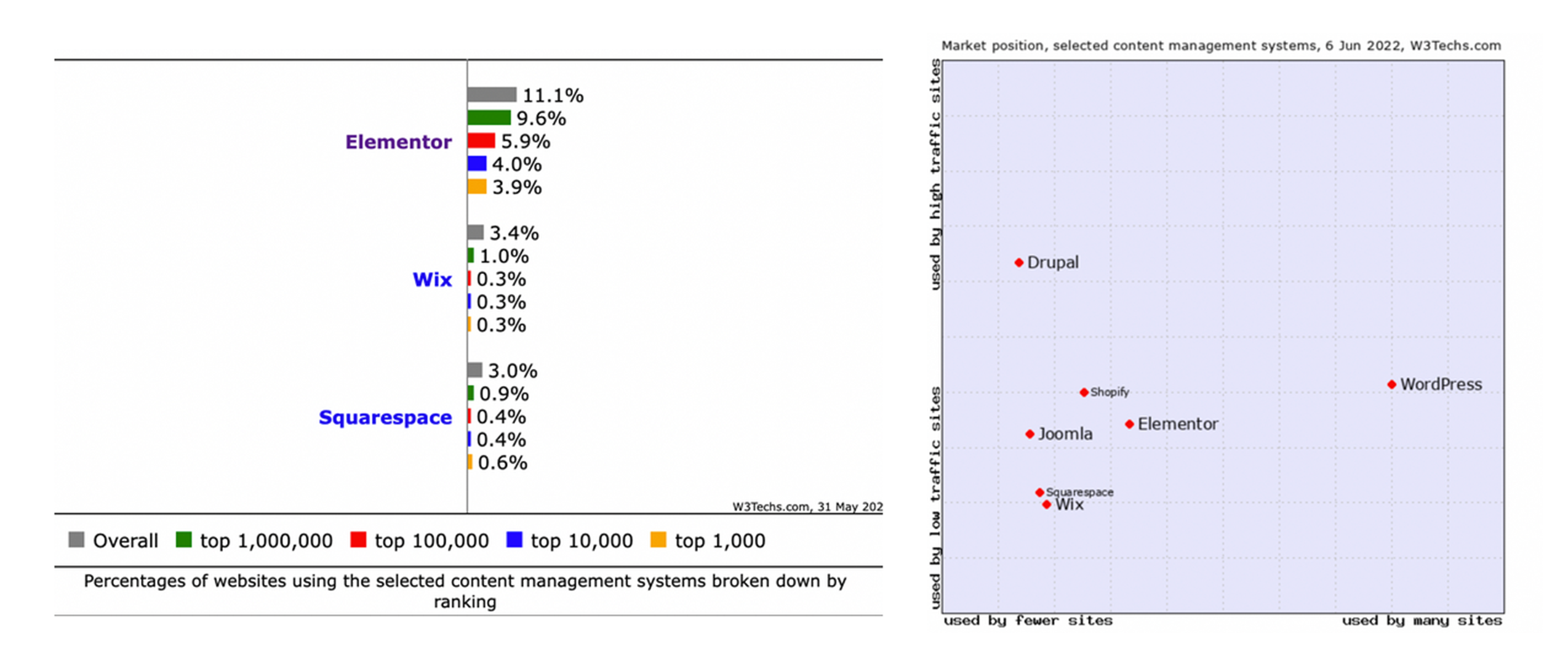Since WordPress launched in 2003, it’s held the dominant share of the Content Management Systems market.
Currently, the popular platform stands at 64.1% market share, according to W3Techs, which offers the most reputable and trustworthy data source.
In this report, you’ll learn about the size of the CMS market, how it has evolved over the past decade, how different content management systems stack up against one another, and why this matters for someone working in SEO.
How Large Is The CMS Market?
According to W3Techs, 68.9% of websites have a CMS, and Netcraft reports 1.15 billion live hostname websites.
From this, we can assume that the current market size for content management systems is approximately 796 million websites.
Top 10 Content Management Systems (CMS) By Market Share (Globally)
| Top 10 CMS, May 2022 | Launched | Type | Market Share | Usage | |
|---|---|---|---|---|---|
| No CMS | 33.10% | ||||
| 1 | WordPress | 2003 | Opensource | 64.10% | 42.90% |
| 2 | Shopify | 2006 | SaaS | 6.40% | 4.30% |
| 3 | Wix | 2006 | Saas | 3.40% | 2.30% |
| 4 | Squarespace | 2004 | Saas | 3.00% | 2.00% |
| 5 | Joomla | 2005 | Opensource | 2.50% | 1.60% |
| 6 | Drupal | 2001 | Opensource | 1.90% | 1.20% |
| 7 | Blogger | 2008 | Opensource | 1.30% | 0.90% |
| 8 | Bitrix | 1999 | Free | 1.20% | 0.80% |
| 9 | Magento | 2012 | Saas | 0.90% | 0.60% |
| 10 | Webflow | 2013 | SaaS | 0.90% | 0.60% |
Data from W3techs, May 2022
What Is The Most Widely Used CMS?
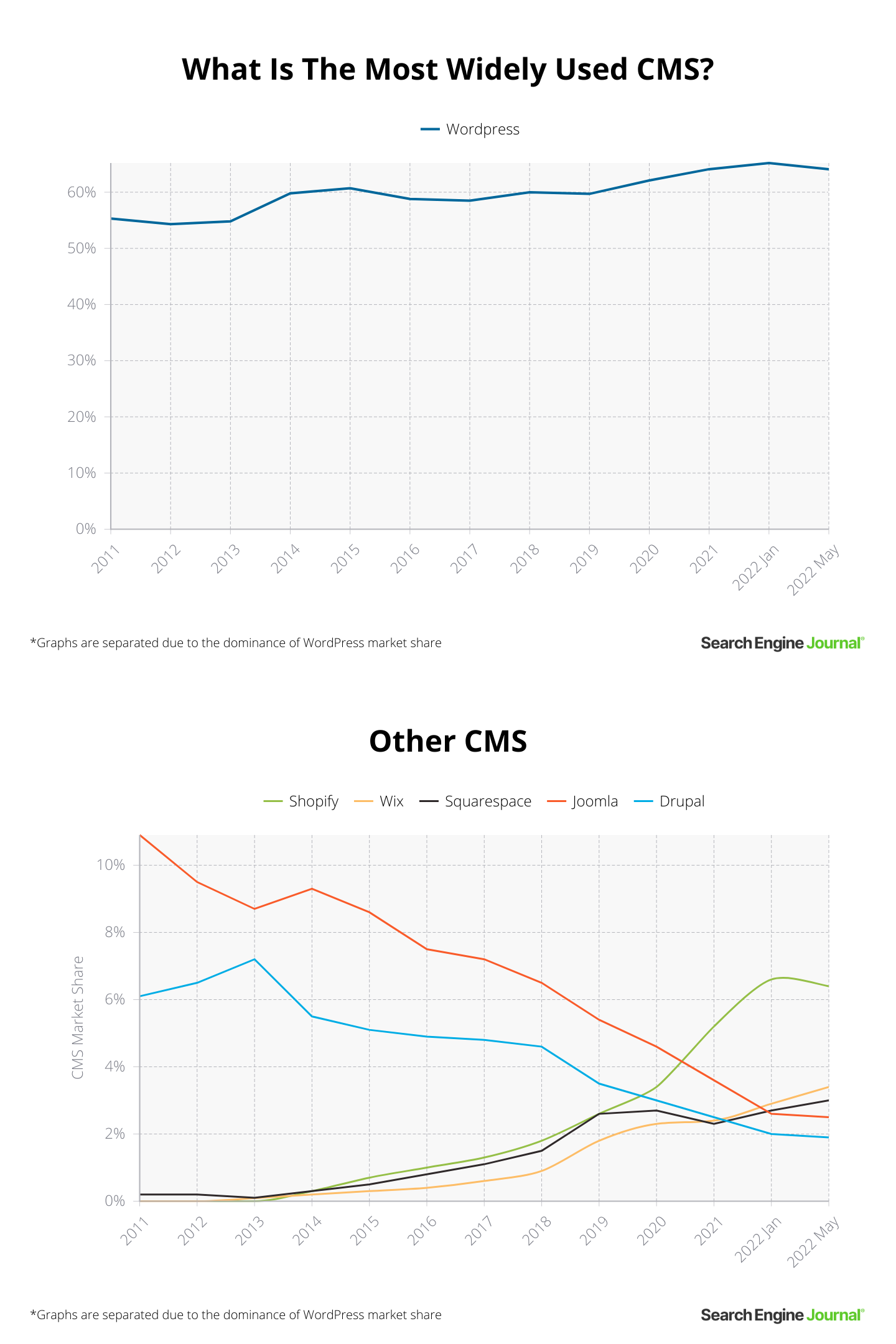 Image from Search Engine Journal, June 2022
Image from Search Engine Journal, June 2022*Graphs are separated due to the dominance of the WordPress market share:
- WordPress market share has increased 16% since 2011 but declined by 2% this year.
- Wix has increased 17% this year.
- Squarespace has increased 11% this year.
WordPress has held the dominant market share almost since its launch in 2003.
Since 2011, that position has been relatively steady – almost stagnant. In 11 years, it’s increased only by 16% to 64.1%.
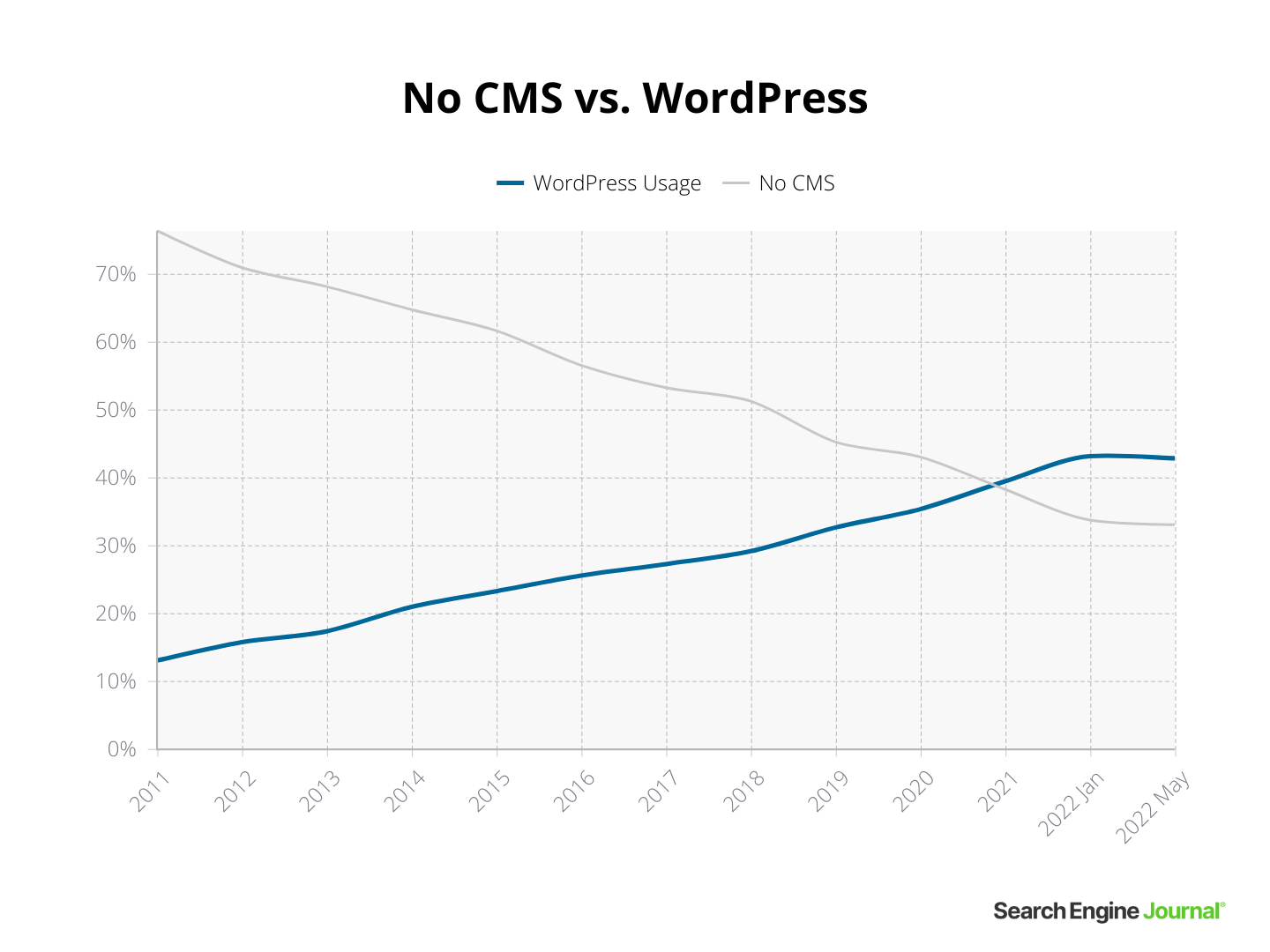 Image from Search Engine Journal, June 2022
Image from Search Engine Journal, June 2022Between 2011 – 2022:
- Websites with no CMS system have declined by 57%.
- Websites with WordPress have increased by 227%.
Joomla vs. Drupal vs. WordPress Market Share
- Since 2011, Joomla has decreased its market share by 77%.
- Since 2011, Drupal has decreased its market share by 69%.
Joomla and Drupal between them used to hold 17% CMS market share, which has slumped to 4.4%.
This decline has seen them drop from positions 2 and 3 to 5 and 6, as Wix and Squarespace have risen and finally superseded them this year.
That’s quite a decline for Joomla, which might not have had the same market share as WordPress but, up to 2008, had more search interest, according to Google Trends.
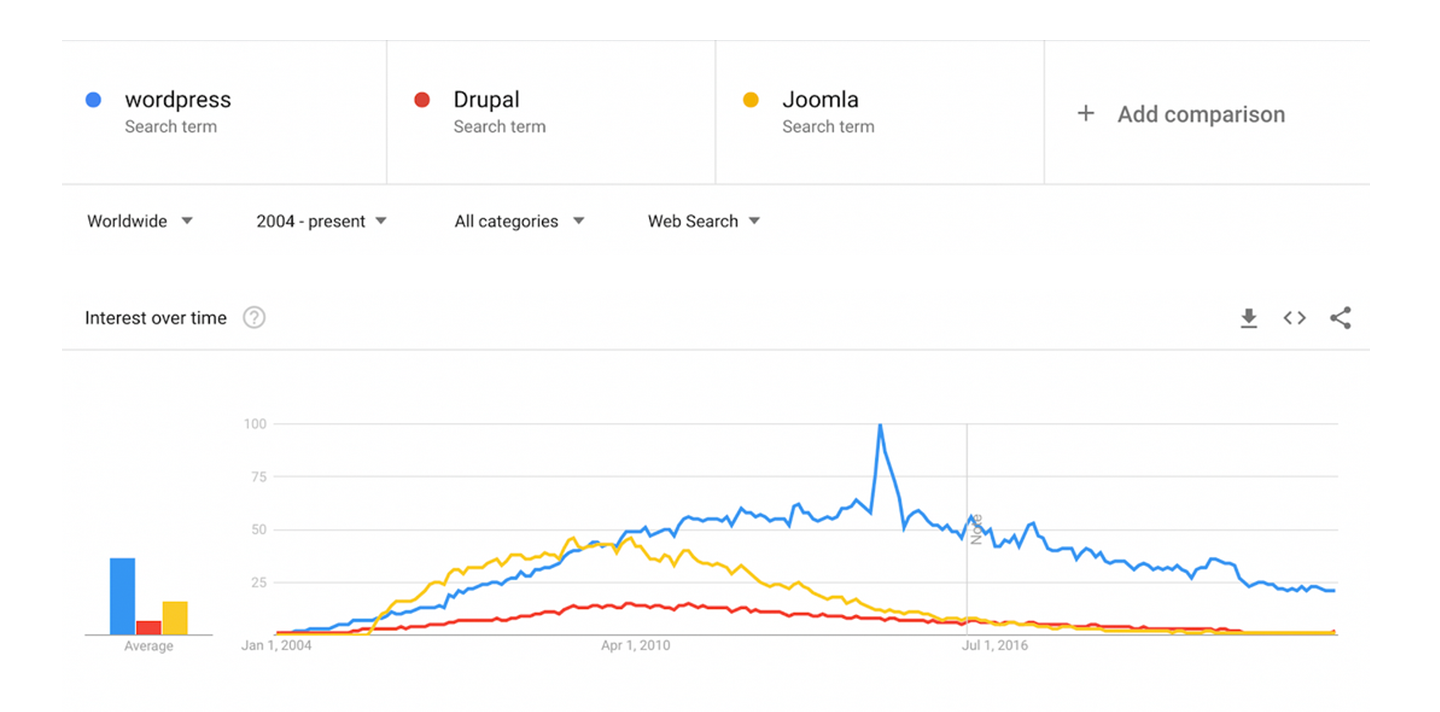 Screenshot from Google Trends, June 2022
Screenshot from Google Trends, June 2022Why did these popular content management systems decline so much?
It’s most likely due to the strength of third-party support for WordPress with plug-ins and themes, making it much more accessible.
The growth of website builders, such as Wix and Squarespace, indicates that small businesses want a more straightforward managed solution. And, they have started to nibble market share from the bottom.
Website Builders Market Share, Wix vs. Squarespace
- Wix has increased 17% this year, from January to May.
- Squarespace has increased 11% this year, from January to May.
If we look at the website builders, their significant growth is a strong indication of where the market might go in the future.
From 2011 to 2022:
- Wix grew by 3,678%.
- Shopify grew by 2,033%.
- Squarespace grew by 1,400%.
When we compare the 16% growth of WordPress over the last 11 years to the other players, that growth for the CMS behemoth becomes even more flattened and stagnant.
Why is that happening?
SaaS web builders such as Wix and Squarespace don’t require coding knowledge and offer a hosted website that makes it more accessible for a small business to get a web presence quickly.
No need to arrange a hosting solution, install a website, and set up your own email. A web builder neatly does all this for you.
WordPress is not known as a complicated platform to use, but it does require some coding knowledge and understanding of how websites are built.
On the other hand, a website builder is a much easier route to market, without the need to understand what is happening in the back end.
Consider that, during the pandemic, much of the population worked from home, leading to more interest and attention placed on how being online could be a source of income.
Elementor is a WordPress-based website builder used by 17.2% of all the websites that use WordPress.
It also has significantly more market share than Wix and Squarespace combined.
However, because it’s a third-party plug-in and not a CMS, it isn’t listed in the Top 10 CMS above.
If we compare the volume of traffic to the number of CMS, we can see that WordPress is in the golden section, up and to the right, clearly favored by sites with more traffic.
Drupal fits into a niche of fewer installs but more high-traffic sites, indicating that more professional sites are using it.
Squarespace and Wix are to the left and down, highlighting that they are installed on fewer sites with less traffic.
A strong indication that they are used more by small websites and small businesses.
Elementor bridges the gap between the two and has the weight of the WordPress market share, but is used by sites with less traffic.
The appetite is growing for drag-and-drop, plug-and-play solutions that make having a web presence accessible for anyone. This is the space to watch.
Ecommerce CMS Market Share, Shopify vs. Woocommerce
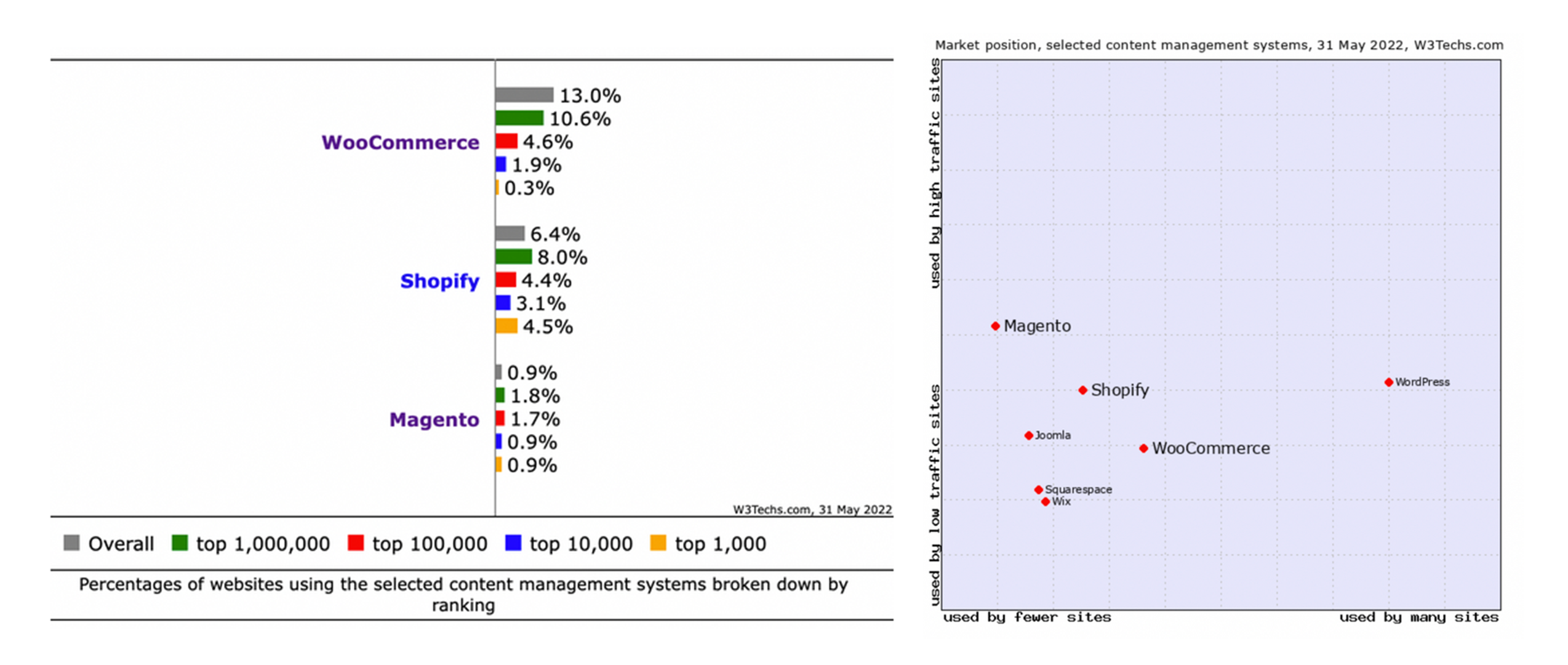 Screenshot from W3 Techs.com, June 2022
Screenshot from W3 Techs.com, June 2022- WooCommerce has a market share of 13%.
- Shopify has a market share of 6.4%.
The ecommerce CMS space echoes a similar pattern to the website builders.
Technically, WooCommerce is not a standalone CMS, but a WordPress plug-in – which is why it doesn’t appear in the Top 10 CMS data table.
However, it’s essential to the ecommerce space, so it’s worth considering and mentioning.
8.7% of all existing websites use WooCommerce, which has a CMS market share of 13.0%.20.3% of all websites that use WordPress use WooCommerce.
Looking at the distribution, we can see a clear pattern emerge. In comparison to other ecommerce CMS platforms, WooCommere is dominant.
It has more market share than the other competitors combined:
Magento + OpenCart + PrestaShop + Shopify = 8.9% market share.
Magento might not have the volume of installs, but high-traffic sites favor it – indicating that Magento is a CMS of choice for bigger and more professional businesses, just as we saw with Drupal.
Smaller sites might favor WooCommerce, but it has the WordPress platform’s weight for market access and, therefore, more installs – much like Elementor.
Shopify has more market share, but the traffic levels are similar to WordPress.
Shopify saw massive growth during the pandemic of 53% from 2020 to 2021, then 27% from 2021 to 2022, far more than any other platform.
Why Does CMS Market Share Matter To Someone Working In SEO?
WordPress retains its dominance in the CMS market share but website builders such as Wix, Squarespace, and Shopify are on the rise, indicating where market growth lies, especially for small businesses.
If more small businesses are switching to website builders, understanding the limitations and intricacies of these platforms for SEO could be a competitive advantage.
Shopify is installed on 4.3% of all websites (not just sites with a CMS): a total potential market of 50 million websites.
With their increasing market share, specializing in Shopify SEO could be a strategic move for an SEO professional.
Similarly, specializing in Wix and Squarespace is a way to differentiate yourself from the competition.
WordPress might be dominant now, but that also means that many other people are servicing that specific CMS.
Aligning with a more niche CMS can be a strategic move for new client opportunities.
More resources:
- Shopify SEO – How to Optimize Your Shopify Site for Google
- Top 6 CMS For Core Web Vitals
- How to Pick the Most SEO Friendly CMS For Your Website [Podcast]
Data sources
All data collected from W3techs, May 2022, unless otherwise indicated.
W3Tech samples its data from the Alexa top 10 million and Tranco top 1 million. Websites with no content or duplicate sites are excluded. Limitations of the data source mean that hosted Tumblr and WordPress.com sites are not included as the data collection doesn’t count subdomains as more than one site.
Featured Image: NESPIX/Shutterstock




